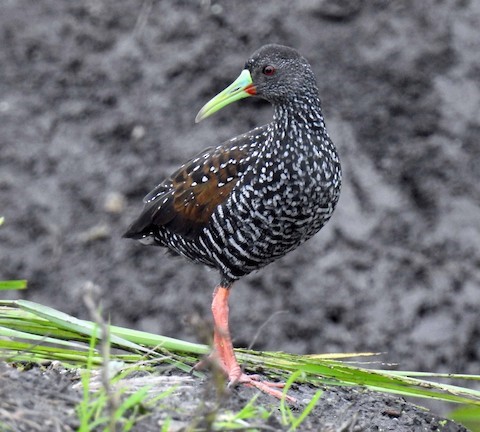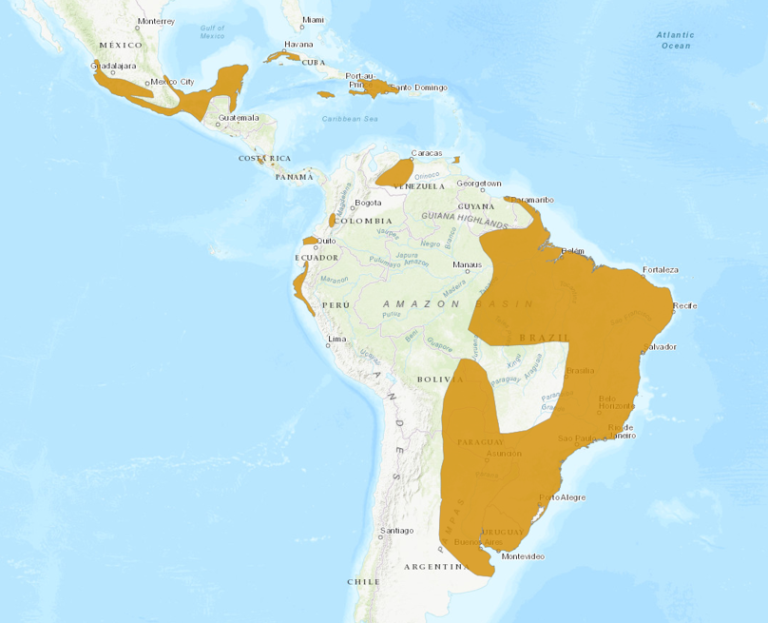Birdfinding.info ⇒ Uncommon, local, and sporadic across most of its large range, but fairly common and widespread across Argentine Mesopotamia and adjacent territories including central Paraguay. Its center of abundance seems to be along the Paraná River in southern Santa Fé. Sometimes found in and around Buenos Aires, but more common northward (e.g., Ceibas, Entre Ríos). Other areas where it has been found regularly include: in Mexico, around San Blas; in Nicaragua, the Sebaco rice fields; in Costa Rica, the rice fields around Palmira and Pelón de la Bajura, Guanacaste; Cuba’s Zapata Swamp (e.g., La Turba and Santo Tomás); Jamaica’s Black River Morass; in Peru, at Rioja and Nuevo Mundo in San Martín; in Brazil, at Arari, Maranhão, and the Tanquã in Piracicaba, São Paulo.
Spotted Rail
Pardirallus maculatus
Tropical wetlands of Middle and South America. Widely but patchily distributed in freshwater marshes, rice fields, and damp grasslands across much of the Neotropics from southern Mexico and the West Indies to central Argentina. Mainly in lowlands, but locally up to around 2,000 m elevation.
In the West Indies, it is known from a few sites on Cuba, Jamaica, Hispaniola, and Trinidad.
In Middle America, it occurs on both coastal plains and in some intermontane valleys from Nayarit and Veracruz south very locally to central Panama.
In northern South America it has been reported from only a handful of areas but is likely much more widespread than the records indicate. These areas include: Pacific lowlands from southwestern Colombia to northwestern Peru; intermontane valleys of central Colombia and northern Peru; the western Llanos of Venezuela; coastal Surinam; and the western rim of Amazonia and lower flanks of the Andes from southern Colombia to eastern Peru.
In eastern and central South America, it has been recorded widely from central Bolivia and Amazonas south through Paraguay, central and eastern Brazil, and Uruguay to Mendoza and Buenos Aires Province.
Prone to wandering and infrequent irruptions, but these movements have no apparent pattern. It has been recorded twice as a vagrant in the U.S.: Beaver County, Pennsylvania (November 12, 1976) and Brown County, Texas (August 9, 1977). There is at least one extralimital record from central Chile: Quilpué (April 26, 2015).
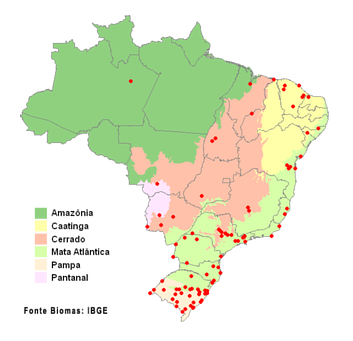
Brazilian records from © WikiAves
Identification
Unique and unmistakable: a medium-large rail with densely barred and spotted black-and-white plumage, mostly brown back and wings, bright coral-pink legs, and a long, heavy lime-yellow bill with turquoise and red patches at its base.
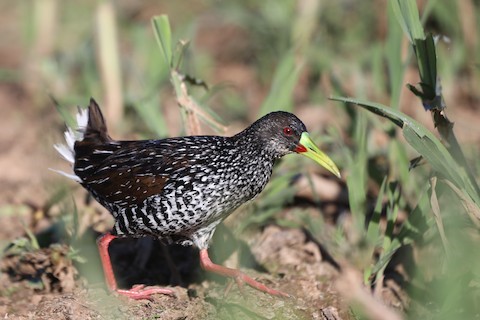
Spotted Rail. (Tanquã, Piracicaba, São Paulo, Brazil; August 29, 2019.) © Ian Thompson
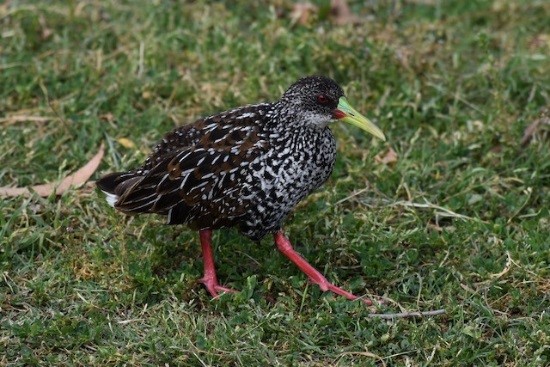
Spotted Rail. (Montevideo, Uruguay; October 23, 2017.) © Roger Woodruff

Spotted Rail, showing nearly all-brown wings. (Ranchos Panabá, Yucatán, Mexico; August 31, 2020.) © Miguel Demeneghi

Spotted Rail. (San Blas, Nayarit, Mexico; March 27, 2018.) © Jason Vassallo

Spotted Rail with extensively warm-brown upperparts. (Costanera Sur Ecological Reserve, Buenos Aires City, Argentina; November 2, 2016.) © Sergio Cusano
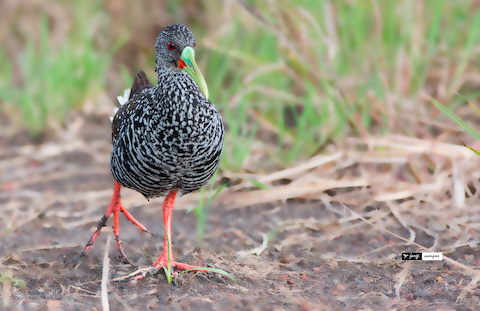
Spotted Rail. (Palmira, Guanacaste, Costa Rica; July 20, 2017.) © Jorge Gabriel Campos
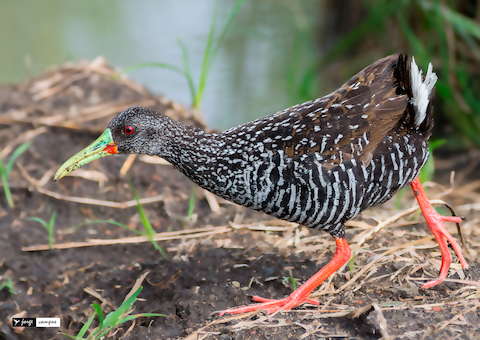
Spotted Rail. (Palmira, Guanacaste, Costa Rica; July 20, 2017.) © Jorge Gabriel Campos
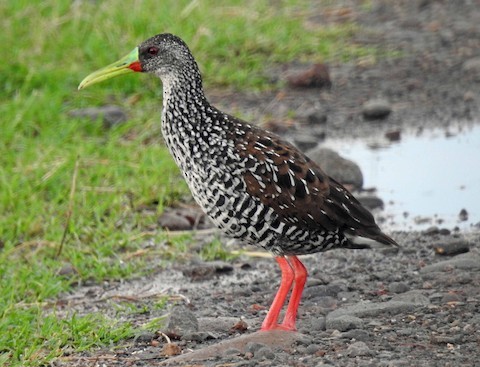
Spotted Rail. (Arrocera del Valle, Matagalpa, Nicaragua; August 15, 2019.) © Danilo Moreno

Spotted Rail. (Fantino, Sánchez Ramírez, Dominican Republic; June 29, 2019.) © Fredy Ruiz

Spotted Rail. (Mburucuyá, Corrientes, Argentina; October 9, 2017.) © Carlos Schmidtutz

Spotted Rail. (Costanera Sur Ecological Reserve, Buenos Aires City, Argentina; November 13, 2016.) © Sergio Cusano

Spotted Rail. (Tanquã, Piracicaba, São Paulo, Brazil; August 29, 2019.) © Ian Thompson

Spotted Rail. (Pelon de la Bajura, Guanacaste, Costa Rica; July 5, 2018.) © Jim Zook
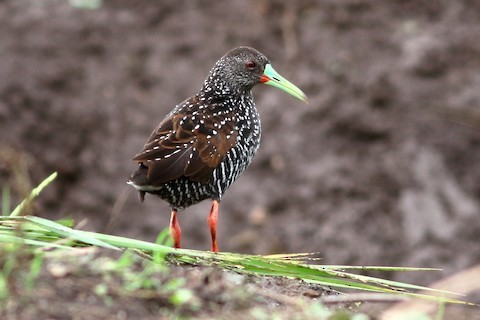
Spotted Rail, showing largely warm-brown upperparts. (Sebaco, Matagalpa, Nicaragua; May 26, 2019.) © Manfred Bienert

Spotted Rail, showing largely warm-brown upperparts. (Costanera Sur Ecological Reserve, Buenos Aires City, Argentina; November 13, 2016.) © Sergio Cusano
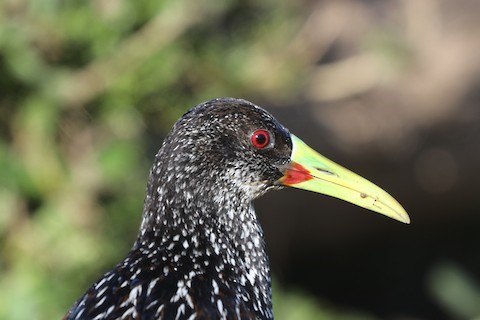
Spotted Rail. (Tanquã, Piracicaba, São Paulo, Brazil; August 29, 2019.) © Ian Thompson

Spotted Rail. (Palmira, Guanacaste, Costa Rica; July 20, 2017.) © Jorge Gabriel Campos
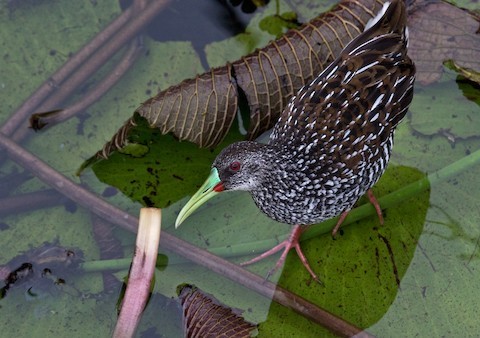
Spotted Rail, showing largely dark-brown upperparts. (Laguna El Oconal, Pasco, Peru; December 2, 2019.) © Lars Petersson

Spotted Rail, showing white undertail coverts. (Pelon de la Bajura, Costa Rica; July 14, 2017.) © Jim Zook
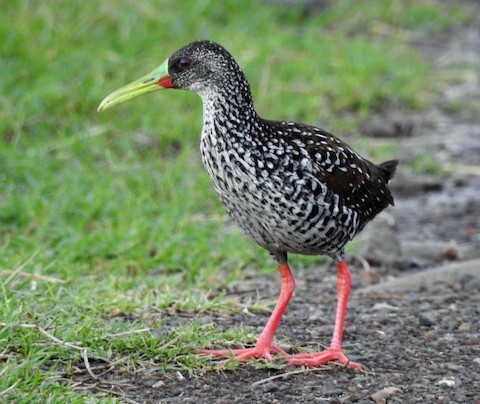
Spotted Rail. (Arrocera del Valle, Matagalpa, Nicaragua; August 15, 2019.) © Danilo Moreno
Juveniles are of three morphs, all recognizable in part because they have dark bills and dark reddish-brown legs. One resembles the adult plumage but browner, with more weakly defined bars and spots. Another is mostly uniform dark-brown. The last is mostly uniform tan- or sandy-brown.
Older immatures resemble adults but have less colorful bills and legs.

Spotted Rail, immature with extensive brown remaining in the underparts. (Tanquã, Piracicaba, São Paulo, Brazil; October 15, 2017.) © Luciano Bernardes
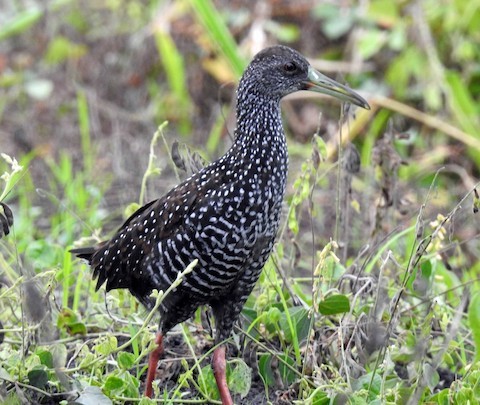
Spotted Rail, subadult. (Sebaco, Matagalpa, Nicaragua; May 26, 2019.) © Danilo Moreno
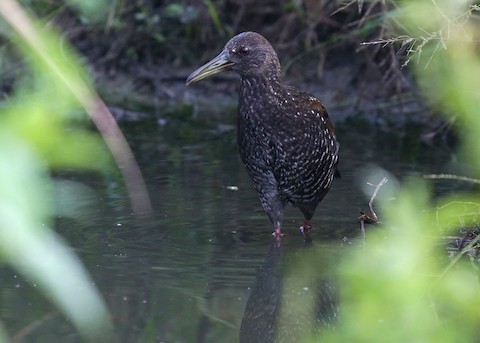
Spotted Rail, immature. (La Joya, Madre de Díos, Peru; June 6, 2020.) © Cesar Bollatty, www.birdsofperutours.com

Spotted Rail, immature. (La Joya, Madre de Díos, Peru; June 6, 2020.) © Cesar Bollatty, www.birdsofperutours.com

Spotted Rail, dark morph juvenile. (Dawson Creek, Orange Walk, Belize; April 3, 2019.) © Isaias Morataya
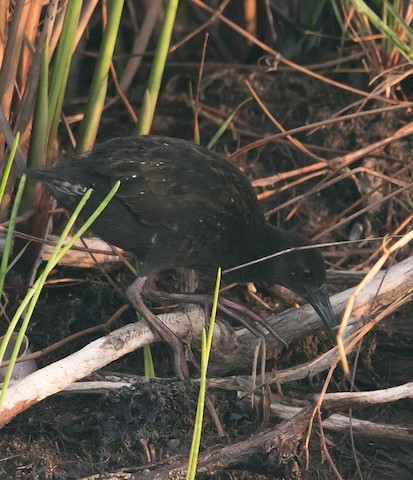
Spotted Rail, dark morph juvenile. (Dawson Creek, Orange Walk, Belize; April 3, 2019.) © Isaias Morataya

Spotted Rail, dark morph juvenile. (Dawson Creek, Orange Walk, Belize; April 3, 2019.) © Isaias Morataya

Spotted Rail, dark morph juvenile. (Dawson Creek, Orange Walk, Belize; April 3, 2019.) © Isaias Morataya
Notes
Polytypic species consisting of two recognized subspecies.
References
Ascanio, D., G.A. Rodriguez, and R. Restall. 2017. Birds of Venezuela. Christopher Helm, London.
BirdLife International. 2016. Pardirallus maculatus. The IUCN Red List of Threatened Species 2016: e.T22692763A93368426. https://dx.doi.org/10.2305/IUCN.UK.2016-3.RLTS.T22692763A93368426.en. (Accessed September 4, 2020.)
eBird. 2020. eBird: An online database of bird distribution and abundance. Cornell Lab of Ornithology, Ithaca, N.Y. http://www.ebird.org. (Accessed September 4, 2020.)
Fagan, J., and O. Komar. 2016. Peterson Field Guide to the Birds of Northern Central America. Houghton Mifflin Harcourt, New York.
ffrench, R. 2012. A Guide to the Birds of Trinidad & Tobago (Third Edition). Cornell University Press.
Garrigues, R., and R. Dean. 2014. The Birds of Costa Rica: A Field Guide (Second Edition). Cornell University Press.
Graves, G.R., V.A. Turland and C. Levy. 2015. History of the Spotted Rail (Pardirallus maculatus) in Jamaica with first photographic documentation of breeding. Journal of Caribbean Ornithology 28:11-14.
Howell, S.N.G., I. Lewington and W. Russell. 2014. Rare Birds of North America. Princeton University Press, Princeton, N.J.
Howell, S.N.G. and S.W. Webb. 1995. A Guide to the Birds of Mexico and Northern Central America. Oxford University Press, Oxford.
Kirwan, G.M., A. Levesque, M. Oberle, and C.J. Sharpe. 2019. Birds of the West Indies. Lynx Edicions, Barcelona.
Latta, S., C. Rimmer, A. Keith, J. Wiley, H. Raffaele, K. McFarland, and E. Fernandez. 2006. Birds of the Dominican Republic and Haiti. Princeton University Press.
McMullan, M., and T. Donegan. 2014, Field Guide to the Birds of Colombia (Second Edition). Fundación Proaves de Colombia, Bogotá.
Raffaele, H., J. Wiley, O. Garrido, A. Keith, and J. Raffaele. 1998. A Guide to the Birds of the West Indies. Princeton University Press, Princeton, N.J.
Ridgely, R.S., and P.J. Greenfield. 2001. The Birds of Ecuador, Volume II: Field Guide. Cornell University Press.
Ridgely, R.S., and J.A. Gwynne. 1989. A Guide to the Birds of Panama (Second Edition). Princeton University Press.
Ripley, S.D. 1977. Rails of the World: A Monograph of the Family Rallidae. David R. Godine, Publisher, Boston.
Schulenberg, T.S., D.F. Stotz, D.F. Lane, J.P. O’Neill, and T.A. Parker. 2007. Birds of Peru. Princeton University Press.
Taylor, B., and B. van Perlo. 1998. Rails: A Guide to the Rails, Crakes, Gallinules, and Coots of the World. Yale University Press.
van Perlo, B. 2009. A Field Guide to the Birds of Brazil. Oxford University Press.
WikiAves, Saracura-carijó, http://www.wikiaves.com.br/saracura-carijo
Xeno-Canto. 2020. Spotted Rail – Pardirallus maculatus. https://www.xeno-canto.org/species/Pardirallus-maculatus. (Accessed September 4, 2020.)
